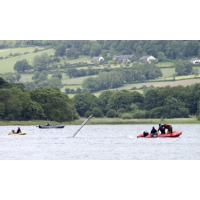Lakebed holds key to hidden history

Lancaster University researchers have been digging deep into the bed of Bassenthwaite Lake in a bid to preserve the future of a rare breed of fish.
On, Thursday, July 1, technicians, research students and staff from Lancaster University’s Geography department took a sediment sample from the lakebed in an attempt to glean crucial information about man’s impact on the environment and wildlife in the lake.
The vendace - an endangered fish species found only in Bassenthwaite and Derwentwater - needs a gravel base to lay and hatch eggs but the increased volume of fine-grained sediment in Bassenthwaite could be hindering their ability to breed.
It is hoped that through examining the samples of material which have built up over several thousand years researchers can glean vital clues about why increasing amounts of sediment are finding their way into upland lakes such as Bassenthwaite. Theories include the impact of sheep grazing, climate change - increased winter rain fall resulting in more run off of top soil - and changing forestry practices.
Using a specially designed corer - developed in the 1950s by a Lakeland-based scientist John Mackereth - the university team went deeper into the lakebed than ever before driving a plastic tube into the sediment and extracting a four metre-long cylinder of material.
The corer was dragged behind an inflatable boat to the centre of the lake. The anchor drum was released, falling to the lakebed 12-15 metres below. Air was then extracted from the drum creating a vacuum seal with the lakebed. Next air was pumped into the top of the corer itself forcing the plastic sample tube into the lakebed.
Once the core sample was taken air was pumped back into the drum forcing the corer out of the ground and up through the water.
Head of department Professor Barbara Maher said: “This is the first time anyone has gone this deep on Bassenthwaite The lake has only been cored to a depth of around one metre in the past. Once we have extracted the sediment sample we can learn a lot about how the environment has changed. The sediment at the bottom of the lake is a natural archive -each layer of sediment tells a story about what was happening at that time. As we look back at the layers, it is like flicking through time in the pages of history book.”
“We hope to be able to 'fingerprint' the more recent sedimentary deposits and trace them back to their source with a view to doing something to mitigate the causes.”
Researchers at Lancaster plan to analyse samples using many different methods including magnetic readings - scanning the length of the core sample and reading it like a barcode to assess the relative inputs of soil and rock particles .